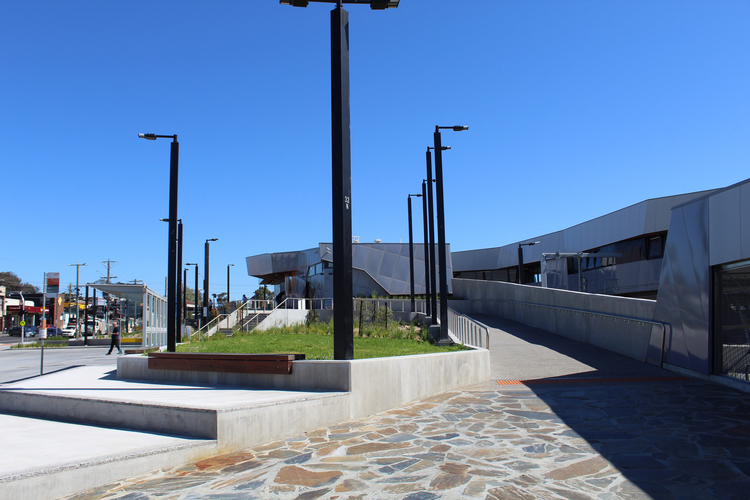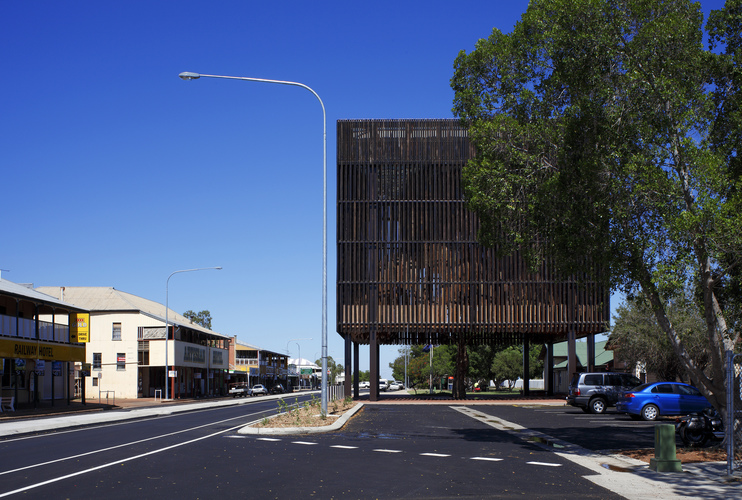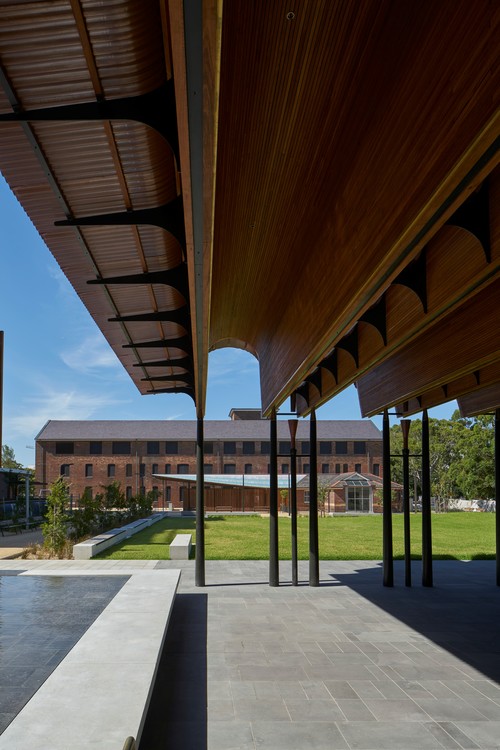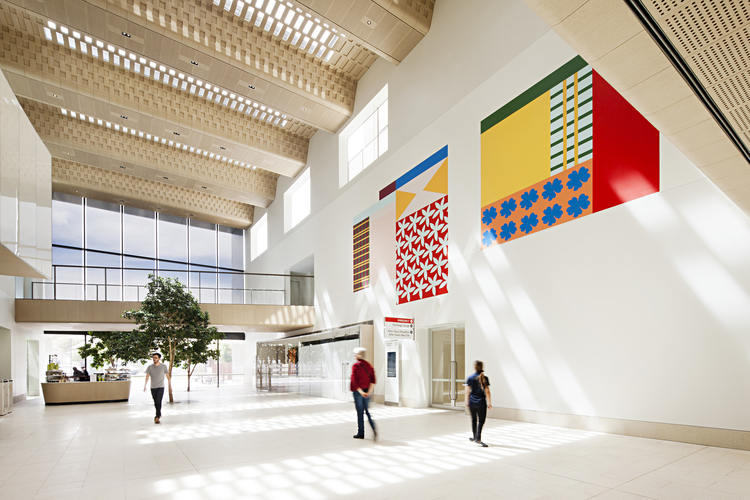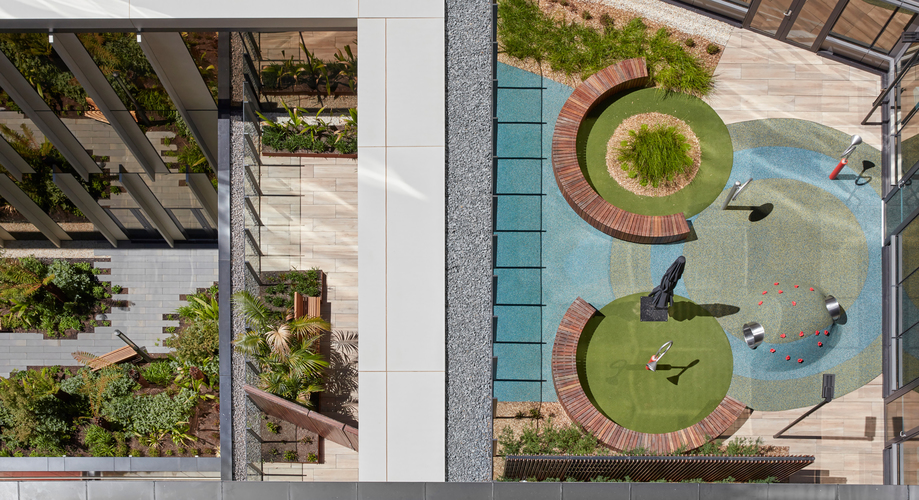2018 Australian Urban Design Awards winners announced
Four outstanding projects have been awarded and six commended in the 2018 Australian Urban Design Awards, the nation’s premier awards for excellence and innovation in urban design. Chosen from a shortlist of thirty-eight projects, the 2018 winners are a new hospital in Bendigo, the transformation of a former hospital site in Sydney, a design guide for central Melbourne and an urban design framework for level crossing removal. The results were announced at a special presentation in Sydney on 25 October.
Bill Chandler, chair of the 2018 Australian Urban Design Awards jury, noted the importance of the awards in encouraging innovation and best practice: “Australia faces many challenges in a rapidly changing world: population change, climate change, the transition of energy production from fossil fuels to renewables, transport, affordable living and sustainability. These are serious issues and urban design has a major role to play in creatively addressing them.
“These awards demonstrate that our urban designers must be and are skilled, innovative, and up to the task. They must be leaders, because our politicians are struggling to stay ahead of the game.”
Chandler said that while the awards assessment criteria are comprehensive, “it is often the ‘X’ factor, the outstanding quality, that separates those projects that are special from those that are simply very competent.”
The Australian Urban Design Awards were created by former prime minister Paul Keating’s Urban Design Taskforce in 1996. The program was established to recognise contemporary Australian urban design projects of the highest quality and to encourage cities, towns and communities across the country to strive for best practice in all projects.
2018 results
Built projects –city and regional scale
AWARD: Bendigo Hospital Project (Vic) by Silver Thomas Hanley with Bates Smart and Oculus.
COMMENDATION: Darling Harbour Transformation (NSW) by Hassell/Hassell and Populous.
COMMENDATION: Barangaroo South (NSW) by Aspect Oculus, Lendlease, Rogers Stirk Harbour and Partners.
Built projects – local and neighbourhood scale
AWARD: Former South Sydney Hospital Site – Stage 1 (NSW) by City of Sydney with Peter Stutchbury Architecture, Design 5, JMD, Sprout Landscape Architecture, CAB, Fox Johnston, Jane Irwin Landscape Architects and CHROFI. AWARD: Main Street Barcaldine (Qld) by M3architecture and Brian Hooper Architect (architects in association). COMMENDATION: Railway Square (WA) by Place Laboratory.
Leadership, advocacy and research – city and regional scale
AWARD: Central Melbourne Design Guide (Vic) by City of Melbourne.
AWARD: Level Crossing Removal Authority Urban Design Framework (Vic) by Level Crossing Removal Authority. COMMENDATION: Urban Choreography: Central Melbourne 1985– (Vic) by Kim Dovey, Rob Adams and Ronald Jones.
Leadership, advocacy and research – local and neighbourhood scale
NO AWARD GIVEN.
COMMENDATION: West Melbourne Structure Plan (Vic) by City of Melbourne.
COMMENDATION: The Living Knowledge Stream Design Guidance for Curtin University (WA) by Syrinx Environmental, Sync7, Dr Noel Nannup.
Built projects – local and neighbourhood scale
AWARD Former South Sydney Hospital Site – Stage 1 by City of Sydney with Peter Stutchbury Architecture, Design 5, JMD, Sprout Landscape Architecture, CAB, Fox Johnston, Jane Irwin Landscape Architects and CHROFI
The former South Sydney Hospital site has transformed a once closed and impenetrable derelict area into a vibrant space that is open and accessible. The integration of carefully curated “installations” with a collection of heritage buildings gives the community a platform for enjoying new activities and celebrating the history of inner-city Sydney. The site provides much needed open space for local residents and accessible connections to the surrounding town centre for visitors passing through. It also underlines the importance of sustainability through passive solar design, battery-supported solar photovoltaics, rainwater capture and re-use, and the use of locally sourced materials. The result is a twenty-first-century cultural and community campus that represents the very best of adaptive re-use and modern placemaking.
AWARD Main Street Barcaldine by M3architecture and Brian Hooper Architect (architects in association)
Main Street Barcaldine demonstrates significant regional investment in high-quality urban design that responds sensitively to the local context. It exhibits excellence in a broad range of criteria associated with this award, including successful activation of public space, sustainable urban governance, increased connectivity and cultural expression. At its heart is the historically and politically significant Tree of Knowledge. The spatial experience pays homage to the canopy that once surrounded the tree and provides a new place for the community to come together and connect. The project displays courage in using urban design as a catalyst for economic revitalisation, seen through increased visitation and pedestrian activity. The use of retail theory is a clear exemplar of economic innovation. The project is further strengthened through the application of meaningful community engagement and the use of integrated decision-making. The result is a beautifully executed main street that the community can treasure now and in the future.
COMMENDATION: Railway Square by Place Laboratory
This space builds on one hundred years of industrial and railway history to make a big statement at a small scale, acting as a centrepiece and consolidating factor for a long-term urban renewal project in the Perth suburb of Midland. By carefully considering multiple points of access, promoting a variety of uses and basing the design on the industrial heritage of the railway yards, the designers have created an active precinct that will form an important part of the community fabric over the next hundred years.
Leadership, advocacy and research – city and regional scale
AWARD Central Melbourne Design Guide by City of Melbourne
The City of Melbourne’s Central Melbourne Design Guide reclaims a long-term planning ambition for central Melbourne. In addition to assisting design and planning professionals, this well-structured, clear and accessible guide will be enormously valuable in communicating the principles and importance of urban design to decision-makers and the broader community. Incorporated into the Melbourne Planning Scheme, the guide has been given the necessary statutory weight to ensure that its design objectives and built environment design quality in general are central considerations in the development application approval process.
Confirming that a high standard of design outcome is worthy of “due regard” in the planning system will vastly enhance the strategic impact of the guide. The graphic presentation and illustrations clearly explain often-abstract rules, bringing them to life and making them readily understandable for a wider audience. This initiative will promote integrated decision-making and support a shared vision for delivering great urban outcomes.
AWARD Level Crossing Removal Authority Urban Design Framework by Level Crossing Removal Authority
What sets this piece of work apart is its application of well-understood urban design principles to what would typically be treated as simply civil and transport infrastructure. At the scale at which the level crossings exist, it might have been easy to treat each one as an exercise in separating traffic. Instead, the development of the framework demonstrates both leadership and a commitment to achieving more from the exercise. Applying a planning and design-led approach that embraces multidisciplinary collaboration to improve the safety of at-grade level crossings will continue to add value to their surrounding neighbourhoods, helping to establish procurement practices that promote multipurpose outcomes benefiting not only the users of transport networks, but also the communities through which they pass.
COMMENDATION: Urban Choreography: Central Melbourne 1985– by Kim Dovey, Rob Adams and Ronald Jones
This compendium of thought-provoking essays documents the transformation of central Melbourne since the mid-1980s. It is, in essence, a biography of the people, policies, places and key moves involved in this global success story. Melbourne’s commitment to the practice of creative urbanism is internationally acknowledged but until now had never been properly documented. This cleverly presented book is essential reading for anyone interested in understanding how one city’s long commitment to strengthening and reimagining its special place qualities might be emulated.
The different but ultimately consistent perspectives of each of the contributing authors and interviewees powerfully describes how forces that shaped the ‘new’ central Melbourne intermeshed and responded to the socioeconomic and political circumstances over several decades. The jury was unanimous in its view that Urban Choreography makes an outstanding contribution to the written history of Australian city planning and demonstrates the incalculable value of sound urban design policy skilfully implemented.
Leadership, advocacy and research – local and neighbourhood scale
COMMENDATION: West Melbourne Structure Plan by City of Melbourne
This plan is notable for its design-led, place-based approach, setting out a clear strategic framework to guide the renewal of an inner-city neighbourhood. Adroitly addressing and resolving competing issues through an innovative set of strategic policies, it ensures that the urban change process protects and strengthens the area’s unique qualities. The plan proposes integrated solutions to a diverse set of environmental planning challenges, including heritage, density, the provision of green infrastructure and the promotion of active travel modes.
A key foundation of the plan’s wide acceptance has been robust and effective community engagement, including peer design review. It is particularly commendable for how it will facilitate the translation of strategic intent into statutory controls to ensure the desired built environment and community-endorsed vision is realised. Too often, comparable documents fail to provide clear guidance around how good urban design policy intentions are realised “on the ground”.
COMMENDATION: The Living Knowledge Stream Design Guidance for Curtin University by Syrinx Environmental, Sync7, Dr Noel Nannup
Curtin University’s “Living Knowledge Stream” document deserves commendation for the richness of its interpretive material, its compelling vision, and its concerted focus on the subtle and particular attributes of the Bentley Campus site. It draws on ecology, hydrology, biology and Indigenous culture to encourage a deep understanding of place. This thoroughly researched and well-illustrated framework presents a comprehensive vision encompassing green infrastructure initiatives, restorative landscape design, creativity, cultural expression and the key aspects of delightful and high-quality public spaces. It represents an intelligent and valuable model for similar education and mixed-use campuses, promising a distinctive and memorable student experience.
